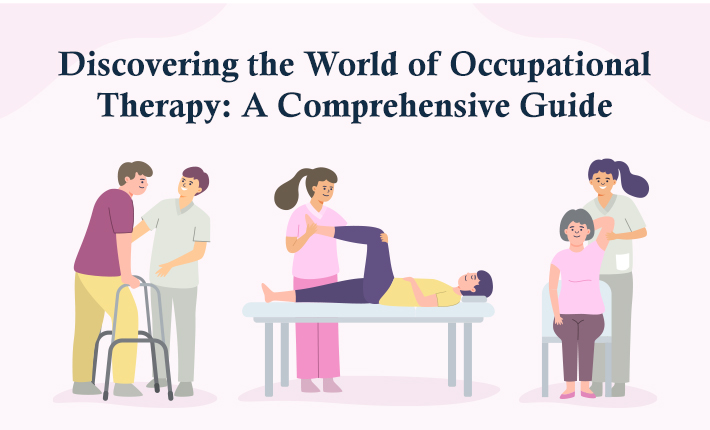This guide is designed to provide a thorough overview of occupational therapy, making it ideal for individuals who are interested in this field and want to learn more. From its target beneficiaries to its specializations, interventions, certification, licensure, job outlook, and salary potential, we will discuss all aspects of occupational therapy. Whether you're curious about this field or considering it as a career, this comprehensive guide will provide valuable insights into the world of occupational therapy. We will cover the fundamentals of what occupational therapy is and what it encompasses, along with the different types of therapies and practice settings that occupational therapists work in. Additionally, we will examine the education and training required to become an occupational therapist, as well as the potential career paths and job opportunities available in this fulfilling profession. So let's begin this exciting journey of exploration and discovery together.
What is Occupational Therapy?
Occupational therapy (OT) is a healthcare profession that focuses on helping people of all ages to participate in daily activities or occupations that they need or want to do. This includes everything from getting dressed and preparing meals, to going to school or work, participating in hobbies, and engaging in social activities. Occupational therapists work with individuals who have physical, cognitive, or emotional challenges that affect their ability to participate in these activities. They use a holistic approach to address the individual's unique needs and goals, and help them to develop the skills and strategies they need to achieve greater independence and quality of life.
OT is based on the principle that engaging in meaningful activities can promote health and well-being. Occupational therapists work with clients to identify the activities that are important to them, and then develop a personalized treatment plan to help them achieve their goals. This may involve teaching new skills, modifying the environment, or using assistive devices to support the individual's participation in daily activities.
History of Occupational Therapy
Occupational therapy has a rich history that dates back to the early 20th century. The profession emerged in response to the need to rehabilitate soldiers who were injured during World War I. At the time, occupational therapy was known as "reconstruction therapy," and focused primarily on helping injured soldiers to regain their independence and return to work.
Over time, the field of occupational therapy expanded to include a wider range of populations and conditions. Occupational therapists began working with children with developmental disabilities, individuals with mental illness, and older adults who were experiencing age-related changes in their ability to participate in daily activities.
Today, occupational therapy is a diverse and dynamic profession that continues to evolve in response to the changing needs of society.
Occupational Therapy vs Physical Therapy
While occupational therapy and physical therapy (PT) share some similarities, there are also some key differences between the two professions. Both OTs and PTs work with clients to promote mobility and improve function, but their focus and approach differ.
PTs primarily focus on improving an individual's physical function, such as strength, range of motion, and balance. They often work with individuals who have experienced injury or illness that affects their ability to move and perform physical activities.
OTs, on the other hand, focus on helping individuals to participate in daily activities that are important to them. They use a holistic approach to address the individual's physical, cognitive, and emotional needs, and help them to develop the skills and strategies they need to achieve greater independence and quality of life.
While the roles of OTs and PTs may overlap, they each bring a unique perspective and skill set to the healthcare team.
Who can benefit from Occupational Therapy?
Occupational therapy can benefit individuals of all ages and abilities who are experiencing challenges in their daily activities. Some of the populations that OTs commonly work with include:
1. Children exhibiting developmental disabilities, notably autism or cerebral palsy, mandate specialized attention and treatment.
2. Individuals who have suffered from a stroke or other neurologic disorders.
3. Older adults who are experiencing age-related changes in their ability to perform daily. activities
4. Individuals with mental illness or emotional challenges.
5. Individuals who have experienced injury or illness that affects their ability to function in daily life.
OTs work with these individuals to help them develop the skills and strategies they need to achieve greater independence and quality of life. This may involve teaching new skills, modifying the environment, or using assistive devices to support the individual's participation in daily activities.
How to become an Occupational Therapist?
Becoming an occupational therapist requires a combination of education and training. Here are the basic steps to becoming an OT:
1. Earn a bachelor's degree: Most occupational therapy programs require that you have a bachelor's degree before applying to graduate school. While there is no specific major required, it is recommended that you have a background in biology, psychology, or a related field.
2. Complete an accredited occupational therapy program: Once you have earned your bachelor's degree, you will need to complete an accredited occupational therapy program. These programs typically take two to three years to complete, and include both classroom instruction and clinical experiences.
3. Complete fieldwork requirements: As part of your occupational therapy program, you will be required to complete a certain number of fieldwork hours. This will give you hands-on experience working with clients in real-world settings.
4. Pass the national certification exam: Once you have completed your occupational therapy program and fieldwork requirements, you will need to pass the national certification exam to become a licensed occupational therapist.
5. Obtain state licensure: In addition to passing the national certification exam, you will also need to obtain licensure in the state in which you plan to practice.
Occupational Therapy Specializations
Occupational therapy is a diverse field, and there are many different specializations that OTs can pursue. Some of the most common specializations include:
1. Pediatrics: working with children with developmental disabilities or other conditions
2. Geriatrics: working with older adults who are experiencing age-related changes in their ability to participate in daily activities
3. Mental health: working with individuals who have mental illness or emotional challenges
4. Hand therapy: working with individuals who have hand or upper extremity injuries or conditions
5. Neurorehabilitation: working with individuals who have experienced stroke or other neurological conditions.
While there are many specializations to choose from, all OTs work to help individuals participate in the activities that are important to them and improve their quality of life.
Occupational Therapy Techniques and Interventions
Occupational therapists use a variety of techniques and interventions to help their clients achieve their goals. Some commonly used techniques and interventions include:
1. Activities of daily living (ADL) training: teaching clients how to perform self-care activities such as dressing, grooming, and bathing.
2. Environmental modifications: modifying the physical environment to support the individual's participation in daily activities, such as installing grab bars or ramps.
3. Assistive technology: using devices or equipment to support the individual's participation in daily activities, such as a wheelchair or hearing aids.
4. Sensory integration therapy: using sensory experiences to help individuals with sensory processing disorders to regulate their responses to sensory input.
5. Cognitive rehabilitation: helping individuals with cognitive impairments to improve their memory, attention, and problem-solving skills.
The specific techniques and interventions used will depend on the individual's goals and needs.
Occupational Therapy Plays a Significant Role in Addressing Mental Health
Occupational therapy plays an important role in the treatment of mental illness and emotional challenges. OTs who specialize in mental health work with individuals who are experiencing a range of conditions, such as depression, anxiety, or bipolar disorder.
OTs use a variety of techniques and interventions to help these individuals manage their symptoms and improve their quality of life. This may include teaching coping skills, providing social support, and helping the individual to engage in meaningful activities. OTs may also work with individuals who have experienced trauma or addiction, helping them to develop the skills they need to recover and move forward.
Occupational Therapy in Pediatrics
Occupational therapy is a valuable resource for children with developmental disabilities or other conditions that affect their ability to participate in daily activities. Pediatric occupational therapists work with children and their families to develop a personalized treatment plan that addresses the child's unique needs and goals.
Pediatric OTs use a variety of techniques and interventions to help children achieve greater independence and quality of life. This may include teaching self-care skills, providing sensory integration therapy, or using assistive technology to support the child's participation in school or play activities.
Occupational Therapy in Geriatrics
As individuals age, they may experience changes in their physical, cognitive, or emotional abilities that affect their ability to participate in daily activities. Occupational therapy can be a valuable resource for older adults who are looking to maintain their independence and quality of life.
Geriatric occupational therapists work with older adults to address a variety of needs, such as mobility, self-care, and social engagement. They may use a variety of techniques and interventions, such as environmental modifications or cognitive rehabilitation, to help the individual achieve their goals.
Occupational Therapy Equipment and Tools
Occupational therapists use a wide variety of equipment and tools to help their clients achieve their goals. Some of the most common equipment and tools used in OT include:
1. Assistive devices: devices or equipment that support the individual's participation in daily activities, such as a wheelchair or walker.
2. Adaptive equipment: equipment that is modified to meet the individual's unique needs, such as a modified eating utensil or computer keyboard.
3. Sensory equipment: equipment that is used during sensory integration therapy, such as weighted blankets or swing chairs.
The specific equipment and tools used will depend on the individual's needs and goals.
Common Occupational Therapy Myths Debunked
There are many myths and misconceptions surrounding occupational therapy. Here are a few of the most common myths, along with the truth behind them:
1.Myth: Occupational therapy is only for people with physical disabilities. Truth: OT can benefit individuals with a wide range of conditions, including mental illness, developmental disabilities, and neurological conditions.
2. Myth: Occupational therapy is only for children. Truth: While pediatric OT is a common specialization, OT can benefit individuals of all ages.
3. Myth: Occupational therapy is not evidence-based. Truth: OT is a research-based profession, and OT interventions are supported by a growing body of evidence.
4. Myth: Occupational therapy is not covered by insurance. Truth: Occupational therapy is often covered by insurance, including Medicare and Medicaid.
Occupational Therapy Education and Training
To become an occupational therapist, you will need to complete a graduate-level occupational therapy program. These programs typically take two to three years to complete, and include both classroom instruction and clinical experiences.
In addition to completing an OT program, you will also need to pass the national certification exam and obtain licensure in the state in which you plan to practice.
Occupational Therapy Certification and Licensure
To become a licensed occupational therapist in the United States, you will need to pass the national certification exam administered by the National Board for Certification in Occupational Therapy (NBCOT). Once you have passed the exam, you will also need to obtain licensure in the state in which you plan to practice.
Each state has its own licensing requirements, which may include additional exams or continuing education requirements.
Job outlook and salary for Occupational Therapists
According to the Bureau of Labor Statistics, the job outlook for occupational therapists is strong, with a projected growth rate of 16% from 2019 to 2029. As of May 2020, occupational therapists salary had median annual salary of $86,210.
The demand for occupational therapy services is expected to increase as the population ages and as more individuals seek rehabilitation services for injuries and illnesses.
Conclusion
Occupational therapy is a diverse and dynamic profession that plays an important role in helping individuals of all ages and abilities to participate in daily activities and improve their quality of life. Whether you are considering a career in occupational therapy or simply interested in learning more about this fascinating field, we hope that this comprehensive guide has provided you with the information you need to get started.
Frequently Asked Questions about Occupational Therapy
Q1: What is the difference between occupational therapy and physical therapy?
A: While both professions focus on improving function and mobility, occupational therapy focuses on helping individuals participate in daily activities, while physical therapy focuses on improving physical function.
Q2: What are the different specializations in occupational therapy?
A: Some common specializations include pediatrics, geriatrics, mental health, and hand therapy.
Q3: What kind of equipment and tools do occupational therapists use?
A: Occupational therapists use a wide variety of equipment and tools, including assistive devices, adaptive equipment, and sensory equipment.
Q4: How do you become an occupational therapist?
A: To become an occupational therapist, you will need to complete a graduate-level occupational therapy program, pass the national certification exam, and obtain licensure in the state in which you plan to practice.
Q5: What is the job outlook for occupational therapists?
A: The job outlook for occupational therapists is strong, with a projected growth rate of 16% from 2019 to 2029.






Leave a reply